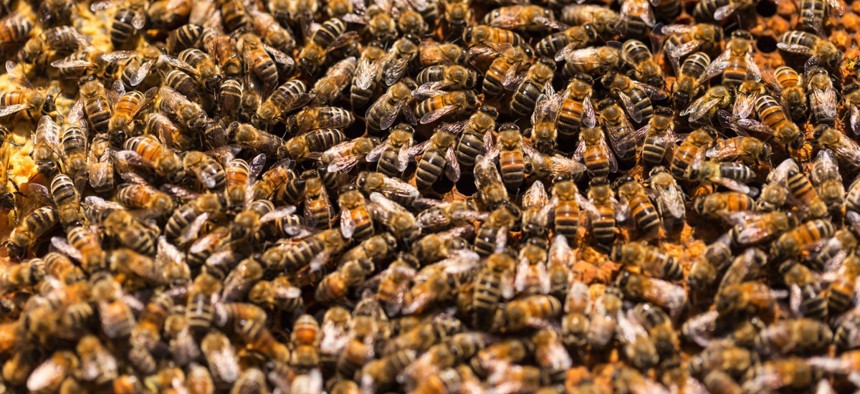This NYPD Counterterrorism Detective Has an Unusual Side Job—Bee Wrangler


Connecting state and local government leaders
For the police department’s official beekeeper, one unexpected side effect of swarm rescue is better community relationships.
When Detective Daniel Higgins joined the New York Police Department he didn’t have a clue that one day, his job would entail wrangling thousands of bees across the five boroughs.
“That’s not one of the things they put on the flier,” he said.
Higgins, whose primary work in the department is in counterterrorism, started beekeeping as a hobby with his father in West Chester, New York, four years ago.
Along with his fellow NYPD beekeeper, Officer Darren Mays, Higgins has been on the bee beat since July 2015. So far this year, the two have caught more than 30 different swarms—the largest of which consisted of an astounding 40,000 bees—equipped with a bee vacuum Higgins built himself.
Honey bees swarm when they run out of space in the hive—which typically happens as the colony is building up its numbers in the late spring and early summer. Worker bees create a new queen (which, in and of itself is a fascinating process), and when she hatches, the virgin queen takes over the existing hive and the old queen flies away, taking about one third of the colony with her. When swarms attach themselves to tree branches or fences—or anything in their path—it’s merely a pit stop for bees on the way to finding a permanent home.
While, a swarm may look dangerous, it usually isn’t. And, many local government agencies around the country take on an active role during swarm season to ensure that bee swarms are safe and make it into the hands of a capable beekeeper.
New York City is relatively unusual in giving that job to the police department. However, Higgins explains that in the bustling urban environment of the biggest city in the country, catching swarms often comes with challenges only the police are able to deal with.
Higgins has caught a swarm that attached itself to a bicycle near Times Square and he’s dealt with swarms in the middle of Park Avenue. On one occasion, when a swarm affixed itself to the side of a building, he had to climb out onto a 6th floor landing with a 12-foot piece of tubing attached to the bee vacuum.
In these cases, and others, Higgins acknowledges that it’s “easier for NYPD to close down a block to remove a bee swarm than it would be for another agency.” Especially if the alternative involves 20,000 bees falling on pedestrians below.
You might not expect thousands of stinging insects to facilitate warmer interactions between police officers and the communities they serve, but that’s exactly what Higgins loves about this part of his job.
“I enjoy beekeeping, but it’s really nice to get out there and interact with the public,” says Higgins, adding “I’ve found it’s really good for community relations. People are so surprised to see a cluster of bees out here in the city. It’s a positive interaction.”
Once the swarm situation is under control, shocked passersby often pepper Higgins and Mays with questions and Higgins lets the inquiring pedestrians take videos and photos of the bees—once they’re safely stowed away in a bucket.
At a time when tense police-community relations are a topic of national conversation, swarm captures allows for Higgins to meet New Yorkers in a neutral context fueled by simple shared curiosity.
Higgins is even trying to take that spirit of community engagement beyond the city’s boundaries. Along with Mays, he runs a bee-centric NYPD Twitter account to share news of swarm rescues along with the videos and photos he takes of this unexpected but rewarding part of his job.
Quinn Libson writes for Government Executive's Route Fifty.

NEXT STORY: Pricey Phone Calls at S.C. County Jail; Is Expanding the Brooklyn Bridge Worth It?





